Paicines Ranch Vineyard
Integrating Livestock as a Management Tool
Paicines Ranch, located south of Hollister, has been operated since the mid-19th century and was purchased by Sallie Calhoun and Matt Christiano in 2001. It consists of 7,600 acres in total, which is divided between 570 acres of farmland and the rest grazing land. The grazing land is temporarily leased to Joe Morris of T&O Cattle Co./Morris Grassfed Beef, which markets grassfed beef directly to the public. Paicines Ranch is managed by Kelly Mulville, who is a Certified Educator with Holistic Management International (HMI), and also a UC Santa Cruz Farm and Garden graduate.
Paicines Ranch’s irrigated bottomland was previously farmed by Earthbound Farms, but the ranch has taken it back and is currently restoring the soils through cover crops and planned grazing. They plan to incorporate a larger variety of crops into their production, resulting in a polyculture of fruit and nut trees and vegetable crops.
The Vineyard
Paicines has planted a 12.5 acre vineyard that is dry-farmed and managed with sheep grazing. The unique Watson Trellis system (see below) was built in Winter 2016-17 for its benefits in sheep-grazed systems, as it is high enough that it allows sheep to graze year-round. Unfortunately, many of the initial young vines and rootstock planted in April 2017 were lost to damage from squirrels and earwigs. The vineyard was replanted in April 2018. Before planting the vineyard, a great deal of planning and site preparation was required.
To prepare the land prior to planting in 2017, the hillsides were disked lightly to smooth the surface before applying compost at 9.3 T/acre.
Spreading Compost - Fall 2014
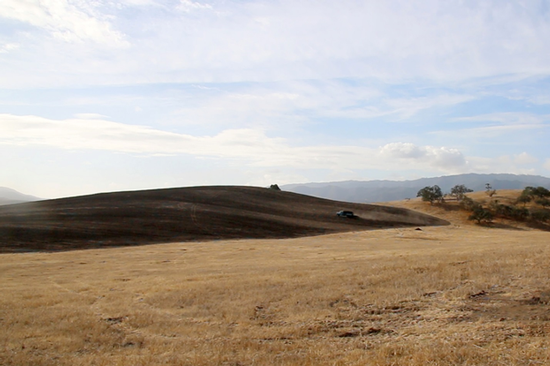
Two years before planting the vineyard, Paicines started planting cover crops (rye, barley, lana vetch, crimson clover, radish) and using planned grazing in order to cycle the nutrients into the soil.
The compost application was followed by cattle grazing, at 7 animal days per acre in the winter/spring of 2014-2015. The site was leveled with a box scraper in the summer of 2015. Ripping of vine rows occurred in the fall of 2015. Sheep and cattle were grazed in winter-spring 2015-2016 at 67 animal days per acre.
Cattle Grazing Vineyard Site - 2015
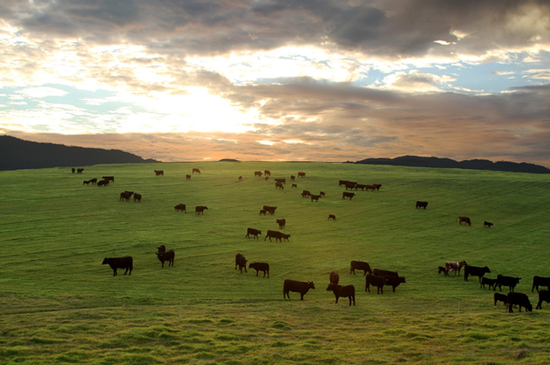
Scraping - Summer 2015
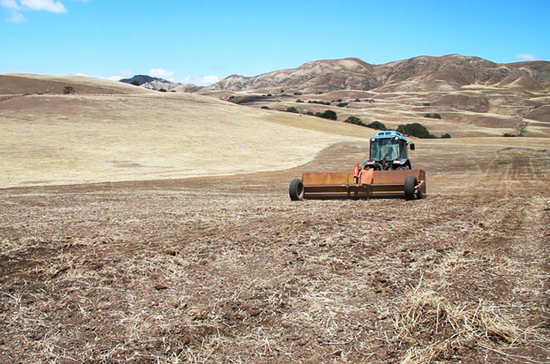
Ripping - Fall 2015
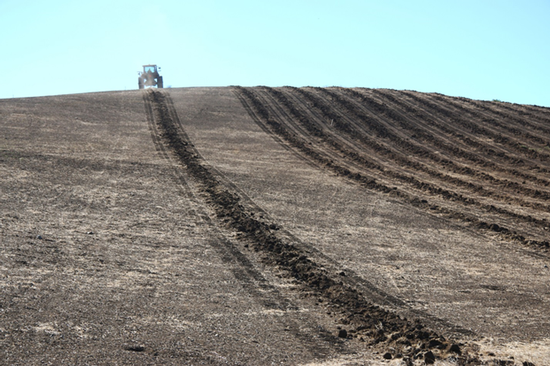
Sheep Grazing Vineyard Site - Spring 2016
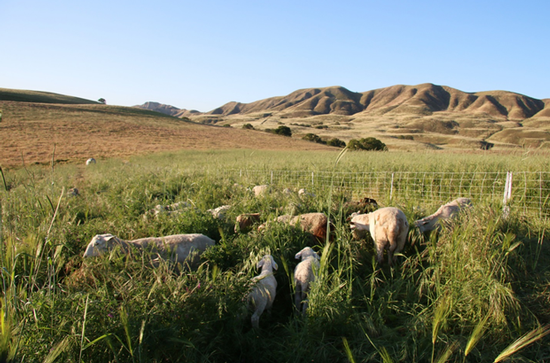
Cattle Grazing Vineyard Site - 2016
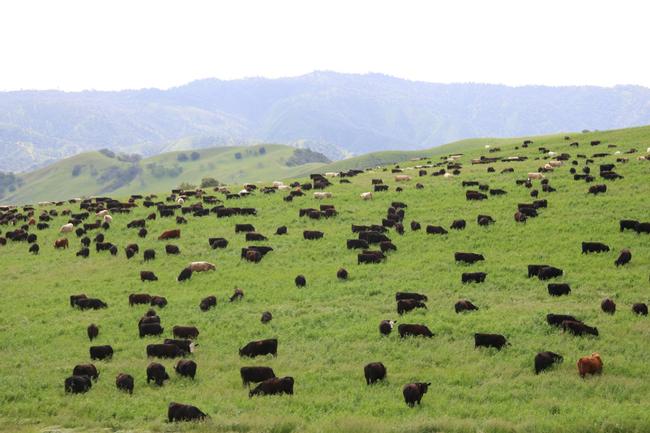
The vines were planted in April 2017 on 1103-P and 110-R rootstock. The vineyard was planted with 12 x 6 foot spacing, adequate for dry farming.
When the majority of the young vines and rootstock were lost to squirrel and earwig damage, Mulville kept the surviving rootstock. In April of 2018 he replanted the other vines that did not survive with a taller rootstock called UberVine. He chose UberVine rootstock because it should catch up quickly to the existing vines and its height will help prevent future earwig problems. In spring of 2019 they plan to graft onto the surviving rootstock utilizing their small on-site nursery, and install 52-inch square grow tubes which allow the sheep to be in the vineyards throughout development. Once they finish spring planting in 2019, one fifth of the vineyard will be vines from the original 2017 planting, one fifth will be UberVines and three fifths will be newly grafted vines. They are anticipating their first grape harvest in 2020. Overhead drip irrigation has been installed as a safeguard against low rainfall, but Mulville plans to wean the vines off of irrigation in a few years.
Vineyard Planting
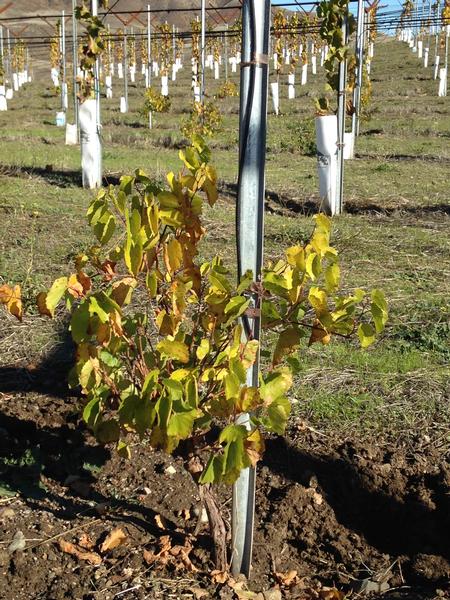
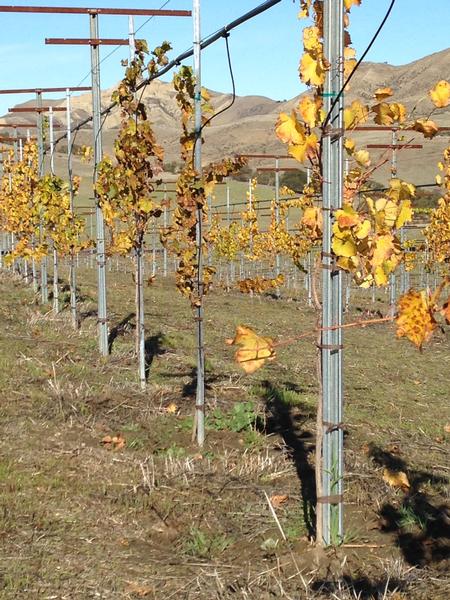
The trellis will be v-shaped, similar to the Watson system used in Texas. This tall trellis system will allow the vines to be trained high enough to graze sheep in the vineyard at any time of the year. Vines will be spur pruned with a divided canopy. The sheep will eat the suckers, the weeds, the cover crop, and the ends of the vine tendrils and cycle a portion of all this back into the soil through manure and urine. The sheep also incorporate litter into the soil with their hooves. This high trellis approach is an alternative to an earlier trial Kelly ran with electric fencing.
Paicines Ranch is already preparing to expand the vineyard on the hill with plans for the vines to come from their onsite nursery. To begin building the soil health, they planted a cover crop in fall 2018 which will be grazed.
Watson Trellis System
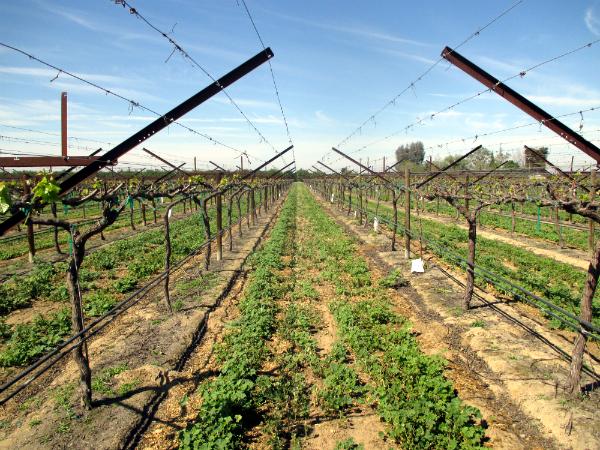
The v-shaped trellis is based on the Watson system from Texas to get the vines higher up off the ground in order to graze the sheep in the vineyard at any time of the year, because even though the cover crop will die down as it heats up, weed growth may increase with irrigation. Vines are spur pruned with a divided canopy. This high trellis approach is an alternative to an earlier trial he ran with electric fencing. With a slight adjustment to narrow the trellises, they will machine harvest in the future in the flat areas.
Mulville estimates the cost of establishment of the vineyard at $25-28,000 per acre.
Sheep as a Management Strategy
Mulville explains that prescribed grazing with sheep, when done correctly to avoid overgrazing, has multiple benefits for the vineyard. As the sheep graze the cover crops, they also eat suckers and weeds and incorporate their urine, manure, and litter into the soil with their hooves. This in turn helps to keep external fertilizer inputs low, although they may use foliar sprays if deficiencies arise. He plans to graze as early as January until well into the growing season. While use of sheep in the winter is common in vineyards, they are typically taken out when the vines start to leaf out, since sheep will eat any grape leaves within reach. In an earlier trial in Sonoma, Mulville set out to find a way for the vineyard to graze the sheep at any time during the year.
“The trial was conducted on a 0.2 hectare vineyard in the Alexander Valley, of Northern California, during the winter, spring and early summer of 2009. Once the system was in place and tested, four medium-sized adult sheep were introduced and monitored for six months - three during which the vines were leafed out. Electrified net fencing was utilized to create small paddocks within the vineyard maintaining stock density at an equivalent of 79 sheep per hectare for most of the trial period.”1
Mulville found the trial accomplished the following:
- Eliminated the need for any mechanical cultivation, tillage or mowing both between rows and under the vines as this task was accomplished through simple grazing moves. This corresponded to 4-8 fewer tractors passes per row/per year and some of the forage consumed was converted to fertility in the vineyard.
- Eliminated the need for hand-suckering of the vine trunks as sheep browsing performed this task. Twenty hours of labour saved per year/per acre and suckers are converted to manure.
- Sheep consumed all canopy lateral and leaf thinnings (removed by hand and placed on ground). Converted this material into manure and eliminated need for disking into soil.
- Reduced on-site irrigation use by 80% from the previous year (2008) during which the vineyard was managed biodynamically and organically. Sheep were grazed from January until the end of March during the non-trial year.
- Increased yield (over previous year) by 1,247 pounds per acre, or about 0.62 Tons.
- Provided on-site fertility in the form of high-quality dung and urine, eliminating the need to haul in compost or other fertilizers. 2
Utilizing UC Cooperative Extension Sample Costs to Produce Organic Wine Grapes (Cabernet Sauvignon) North Coast Region (2005), Mulville calculated the savings per acre in his trial as follows: $112 – hand suckering, $116– weeding, $62 – mowing/disking, $68 – fertilizing, and $33 –irrigation, for a total savings of $391 per acre. If the additional yield was actually due to these methods and not just to the year’s favorable climate, then that would increase the return on these practices.
This savings is offset by costs associated with the sheep. He calculated the annual cost of the electric deterrent system at $96 per acre. The cost of the sheep themselves depends on whether they are rented, borrowed, or purchased. You could buy sheep (and later sell them), run a neighbor’s sheep, or hire someone to custom graze.3 But the sheep must be managed to prevent overgrazing and excessive trampling in the vineyard.
A group of neighbors could work with a flock of sheep. Someone goes once a day to check on the sheep and moves them every 1-3 days. He states that little savings will be realized if the sheep are only grazed in winter if the grower must pay for the sheep; he estimates that about $100/acre can be saved if the grower has their own sheep.
When he began the trial in Sonoma he did not expect the water savings, which was the biggest surprise. He credits these savings to the permanent cover provided by the cover crops, which increases infiltration of rain, and reduces run-off. Trying to mimic nature led to unanticipated benefits.
Incorporating the use of animals in the system also works well with Mulville’s management style; he prefers to reduce his use of machinery and equipment and instead have the sheep do the work. Keeping the ground covered means that less irrigation is required. By practicing no-till, compaction from tractors is also reduced, and mycorrhizae are allowed to flourish. “They’re as good as the vine at getting water”, says Mulville. "It is a different kind of farming, a different culture of management, where you are not dealing with machinery but instead with animals. So many farmers are obsessed with machines."
As for meeting the vines' nutrient needs, rather than being concerned with dialing in a particular nitrogen level, he believes that with a very healthy soil with good pH balance, nitrogen takes care of itself. The plan for the vineyard at Paicines Ranch is to use no additional inputs.
Cover Crops and Grazing Trials
In 2018-19 Mulville planted a winter cover crop mix of oats, bell beans, and lana vetch in the vineyards.
On the irrigated cropland that they recently re-acquired, Paicines Ranch has conducted trials with various cover crops such rye, Molina, wheat, oats, vetch, and peas combined with grazing. Some of this land was harvested, including a block of triticale. They were also able to harvest and sell oat seed from a 76-acre block.
Future Plans
Paicines Ranch plans to continue to build upon their prescribed grazing system and other areas of production. One way of doing this will be to plant fruit and nut trees, grains, seed crops, forage, hedgerows and eventually vegetables in a type of permaculture system. They plan to alley crop the vegetables between the tree crops.
